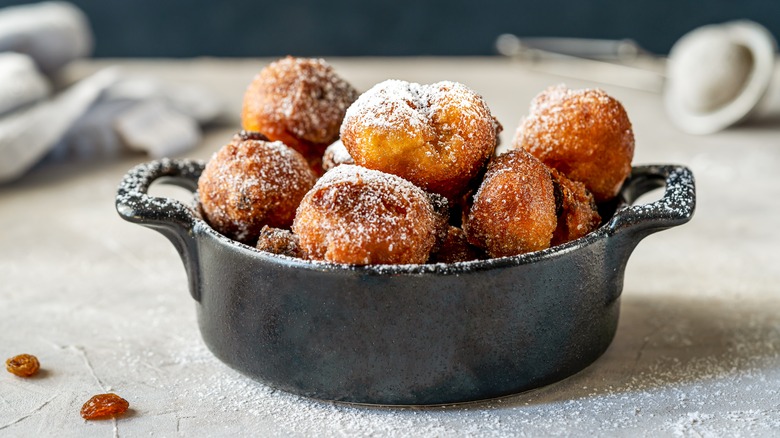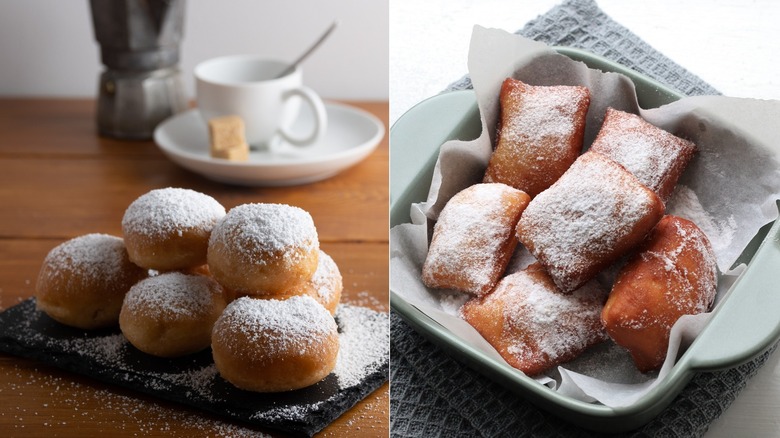The Main Difference Between Beignets And Zeppoles
Nowadays, you don't have to cross the Atlantic Ocean, travel to the French Quarter of New Orleans, or wander the Italian neighborhoods of New York to find European pastries like beignets and zeppoles — chances are you can pick some up at a local bakery or in the baked goods area of your grocery store. But just because they are more available doesn't mean that it's always clear what it is that differentiates beignets and zeppoles from other kinds of doughnuts — or each other. These two forms of sugar-coated fried dough have a lot in common, but there are a couple of key aspects that set them apart.
Besides their countries of origin, the primary difference between French beignets and Italian zeppoles is their distinctive shapes. While beignets are neatly cut into rectangular pieces before frying, zeppole are free-form spheres as a result of the way that they are scooped with a spoon into hot oil. But it's not only their appearances that make them unique — the flavor and texture of the dough inside is also one-of-kind. For beignets, the presence of yeast accounts for an incredibly airy dough – while the addition of ricotta in zeppoles lends to a luscious (but loose) moist interior.
How culinary heritage shapes fried dough
From doughnuts in America to sufganiyot in the Jewish diaspora, just about every culture has its own name and style of making fried dough. The beignets that are so closely associated today with Cafe du Monde in New Orleans came to Louisiana along with French colonists during the eighteenth century, but their history in France extends further back by at least two centuries. French pastries are known for their precision, and the dough of beignets is carefully sliced into rows of uniform rectangles, which puffs up into a pile of identical pillowy treats when fried. They are traditionally eaten during the annual celebration of Mardi Gras, served hot and sprinkled with powdered sugar.
Like beignets, zeppole are frequently consumed in Italy during the period of Carnevale, which also takes place pre-Lent. Italy and France, however, have different cultural approaches to baking. Italian pastries are often characterized by their unique, quirky appearances based on a more casual style of cooking, as is shown in the varying shapes and sizes of zeppole. The dough is generally spooned into the frying oil without hyper-specific measurements or tools, but, as with beignets, they're ultimately meant to be sweetened and enjoyed immediately.
Distinct doughs and serving styles
The core ingredients of beignets and zeppole are very similar. Both are usually made with flour, sugar, salt, and eggs. There are two ingredients, however, that account for significant textural differences between the two. When it comes to beignets, the recipe generally calls for yeast, which gives these pastries their signature rise, resulting in a light-as-air dough with a slightly bready taste. Yeast is less common in zeppole, though they do often contain another ingredient that may be surprising: ricotta. If you are looking for your one and only zeppole recipe, be sure it includes this creamy cheese, which is a staple of Italian cuisine and adds moisture, as well as a mild sweetness, to the dough.
Whether you opt to buy or fry your own beignets or zeppole, be sure to brew strong coffee to serve along with them, as is customary in both French and Italian cultures — but if you have beignets, add chicory to your cup. While powdered sugar is traditional, feel free to get creative with your toppings. Beignets and zeppole are delicious dipped into hazelnut spread or drizzled with jam or honey.



